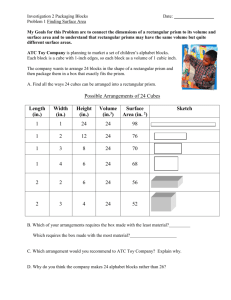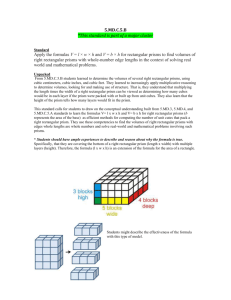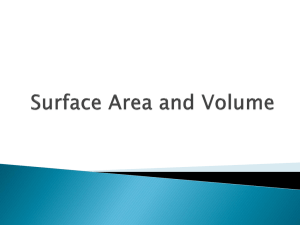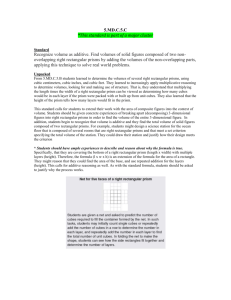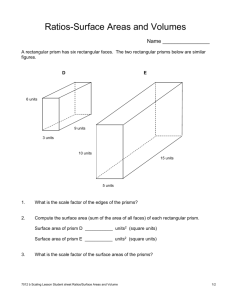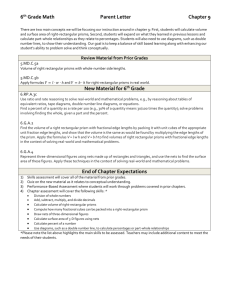DOC - EduGAINS
advertisement
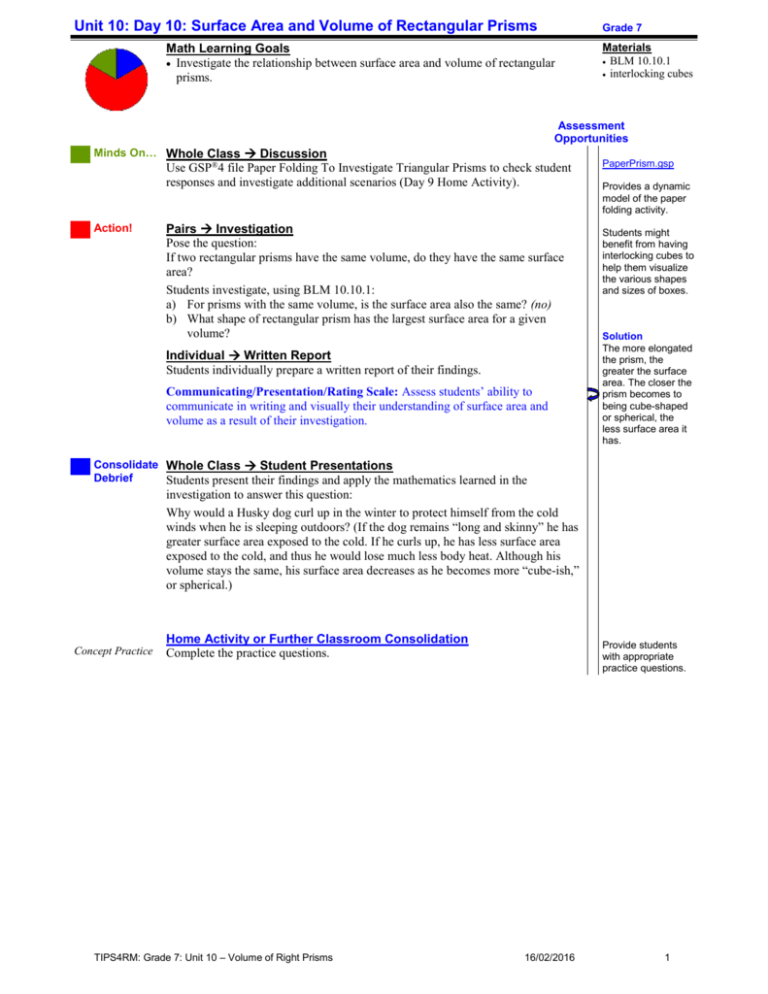
Unit 10: Day 10: Surface Area and Volume of Rectangular Prisms Grade 7 Math Learning Goals Investigate the relationship between surface area and volume of rectangular prisms. Materials BLM 10.10.1 interlocking cubes Assessment Opportunities Minds On… Whole Class Discussion Use GSP®4 file Paper Folding To Investigate Triangular Prisms to check student responses and investigate additional scenarios (Day 9 Home Activity). Action! Pairs Investigation Pose the question: If two rectangular prisms have the same volume, do they have the same surface area? Students investigate, using BLM 10.10.1: a) For prisms with the same volume, is the surface area also the same? (no) b) What shape of rectangular prism has the largest surface area for a given volume? Individual Written Report Students individually prepare a written report of their findings. Communicating/Presentation/Rating Scale: Assess students’ ability to communicate in writing and visually their understanding of surface area and volume as a result of their investigation. PaperPrism.gsp Provides a dynamic model of the paper folding activity. Students might benefit from having interlocking cubes to help them visualize the various shapes and sizes of boxes. Solution The more elongated the prism, the greater the surface area. The closer the prism becomes to being cube-shaped or spherical, the less surface area it has. Consolidate Whole Class Student Presentations Debrief Students present their findings and apply the mathematics learned in the investigation to answer this question: Why would a Husky dog curl up in the winter to protect himself from the cold winds when he is sleeping outdoors? (If the dog remains “long and skinny” he has greater surface area exposed to the cold. If he curls up, he has less surface area exposed to the cold, and thus he would lose much less body heat. Although his volume stays the same, his surface area decreases as he becomes more “cube-ish,” or spherical.) Concept Practice Home Activity or Further Classroom Consolidation Complete the practice questions. TIPS4RM: Grade 7: Unit 10 – Volume of Right Prisms Provide students with appropriate practice questions. 16/02/2016 1 Unit 10: Day 10: Surface Area and Volume of Rectangular Prisms (A) Mathematical Process Goals Hypothesize whether rectangular prisms of fixed volume have surface areas that vary or not. Reason inductively to prove a hypothesis. Grade 7 Materials BLM 10.10.1(A) interlocking cubes Assessment Opportunities Minds On… Whole Class Discussion Mathematical Process Focus: Reasoning and Proving Use GSP®4 Paper Folding To Investigate Triangular Prisms to check student responses and investigate additional scenarios (Day 9 Home Activity). See TIPS4RM Mathematical Processes package pp. 3–4. Action! Pairs Investigation Students make a prediction about the surface area of two rectangular prisms that have the same volume. Students investigate, using BLM 10.10.1(A). Individual Written Report Students individually prepare a logical and organized written report of their findings. Possible guiding questions: How did you refine your prediction as evidence was gathered? What details are needed in your report so that your argument is convincing? Mathematical Process/Reasoning and Proving/Checklist: Observe students as they communicate their solutions, noting the correct use of mathematical terminology as they share their reasoning. Consolidate Whole Class Discussion Debrief Pose the following question: Concept Practice What similarities and differences did you notice about the surface area and the volume in the question of Part A and Part B. Is this always true? Home Activity or Further Classroom Consolidation Predict, verify, and conclude the shape of the rectangular prism that will have the least amount of surface area if the rectangular prism has a volume of: 24 cubic units; 12 cubic units; 16 cubic units. Grade 7 Unit 10 Adjusted Lesson: Mathematical Processes – Reasoning and Proving 16/02/2016 2 10.10.1(A): Wrapping Packages Part A: Three different rectangular prism-shaped boxes each have a volume of 8 cubic units. 1. Make a prediction: Does each box require the same amount of paper to wrap? 2. Determine the amount of paper required for each by calculating the surface area. (Ignore the overlapping pieces of paper you would need.) 3. Describe your findings. Do they support your prediction? Grade 7 Unit 10 Adjusted Lesson: Mathematical Processes – Reasoning and Proving 16/02/2016 3 10.10.1(A): Wrapping Packages (continued) Part B: 1. Construct three different rectangular prism-shaped boxes such that each has a volume of 27 cubic units. Sketch the boxes indicating the dimensions. 2. Make a prediction: Does each box require the same amount of paper to wrap? 3. Determine the amount of paper required for each by calculating the surface area. (Ignore the overlapping pieces of paper you would need.) 4. Describe your findings. Do they support your prediction? Grade 7 Unit 10 Adjusted Lesson: Mathematical Processes – Reasoning and Proving 16/02/2016 4
